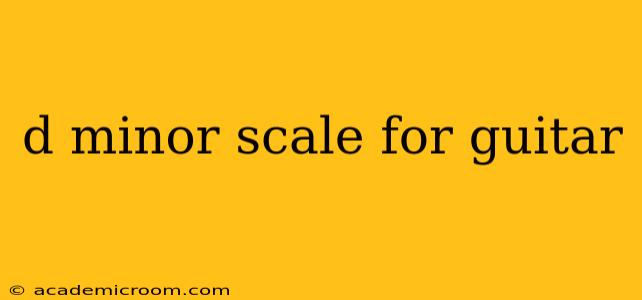The D minor scale is a cornerstone of music theory and a favorite among guitarists. Its melancholic yet powerful sound lends itself to various genres, from blues and rock to classical and jazz. This guide will explore the D minor scale on the guitar, covering its construction, different positions, common chord progressions, and applications in music.
What is the D Minor Scale?
The D minor scale is a seven-note scale built using a specific pattern of whole and half steps (whole step = 2 frets, half step = 1 fret). Its formula is: W-H-W-W-H-W-W, where W represents a whole step and H represents a half step. Starting on D, the notes are: D - E - F - G - A - Bb - C - D.
How to Play the D Minor Scale on Guitar
The D minor scale has numerous positions on the fretboard. Here are a few of the most common and useful:
First Position (Root Position):
This position starts on the open D string.
e|--5--7--8--10--10--12--12--
B|--5--7--8--10--10--12--12--
G|--5--7--7--8--10--10--10--
D|--5--5--5--7--7--7--7--
A|--3--3--3--5--5--5--5--
E|--0--0--0--0--0--0--0--
Second Position:
This position offers easy access to higher notes.
e|--7--8--10--12--12--15--15--
B|--7--8--10--12--12--15--15--
G|--7--8--8--10--12--12--12--
D|--7--7--7--8--10--10--10--
A|--5--5--5--7--7--7--7--
E|--3--3--3--5--5--5--5--
Third Position (Common Pentatonic Shape)
This uses a common pentatonic shape and is useful for improvisation
e|--10-12-13-15-17-
B|--10-12-13-15-17-
G|--8--10-12-13-15-
D|--10-10-10-12-12-
A|--8--8--8--10-10-
E|--5--5--5--7--7--
These are just a few examples; many more positions are possible! Experimenting and finding positions that feel comfortable for your hand is crucial.
Different Variations of the D Minor Scale
While the natural minor scale is the most common, other variations exist:
- Harmonic Minor: This scale raises the 7th degree by a half step, adding a characteristic tension. In D harmonic minor, the 7th would be a C#.
- Melodic Minor: This scale raises both the 6th and 7th degrees ascending and then reverses the change descending.
D Minor Chord Progressions
The D minor scale lends itself well to many common chord progressions. Here are some examples:
- Dm - Gm - C - F: A very common progression in many styles.
- Dm - Am - C - G: Another popular and versatile progression.
- Dm - Am - Bb - C: More sophisticated, with the Bb adding a touch of jazz flavor.
Common Questions about the D Minor Scale
What are the chords in the D minor scale?
The chords built from the D minor scale include Dm (D minor), Em (E minor), F (F major), Gm (G minor), A (A major), Bbm (Bb major), and C (C major). These chords are all diatonic to the D minor scale.
How is the D minor scale used in different genres?
The D minor scale is prevalent across numerous genres. In blues, it's often used for creating melancholic riffs and solos. In rock, it offers powerful and dramatic sounds. In classical music, it can create emotionally evocative passages. Jazz musicians will utilize its chords and scales for improvisation.
What are some songs that use the D minor scale?
Many famous songs incorporate the D minor scale, although identifying the entire scale in a song is less common than using particular notes or chords within the scale. Searching online for songs in "D minor key" will give you many results.
How can I improve my D minor scale fluency?
Practice is key! Start slowly, focusing on accuracy. Gradually increase your speed, ensuring you maintain clarity and evenness. Try playing along with backing tracks, improvising melodies over chord progressions in D minor. Use a metronome to develop rhythm and timing.
By understanding the structure and applications of the D minor scale, you'll unlock a vast world of musical possibilities on the guitar. Consistent practice and exploration will help you master this fundamental scale and elevate your playing.
